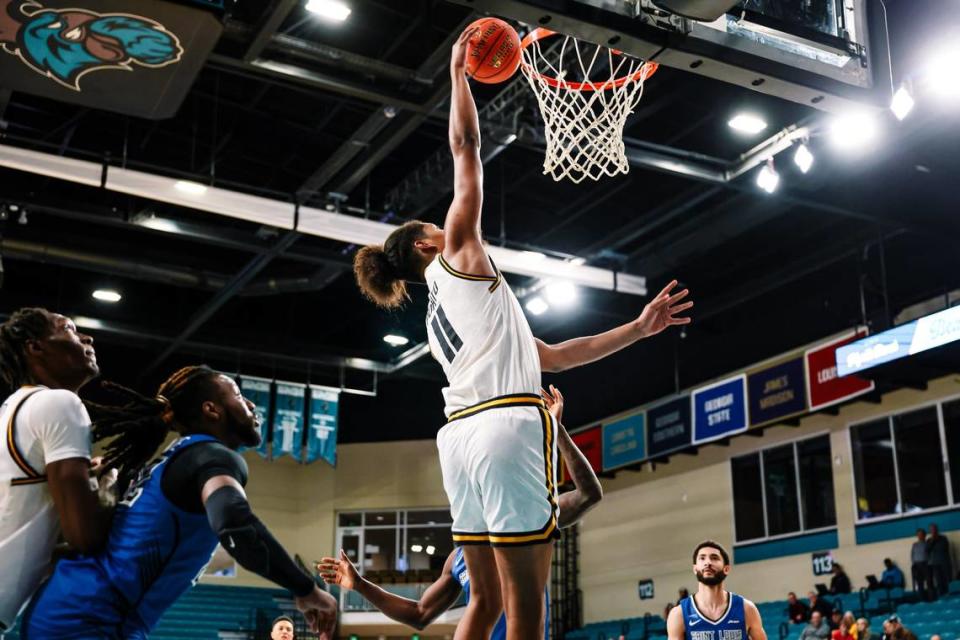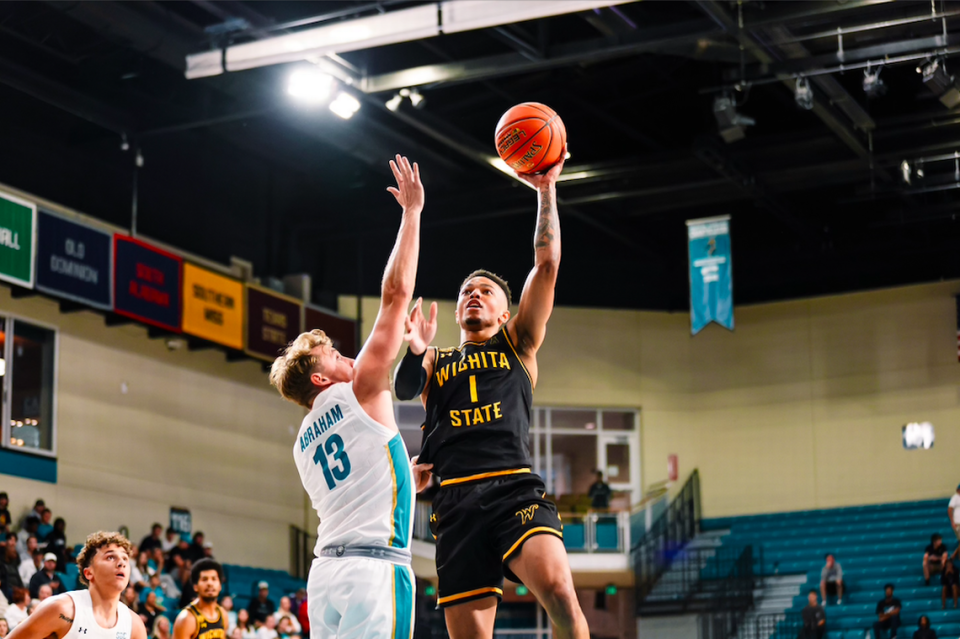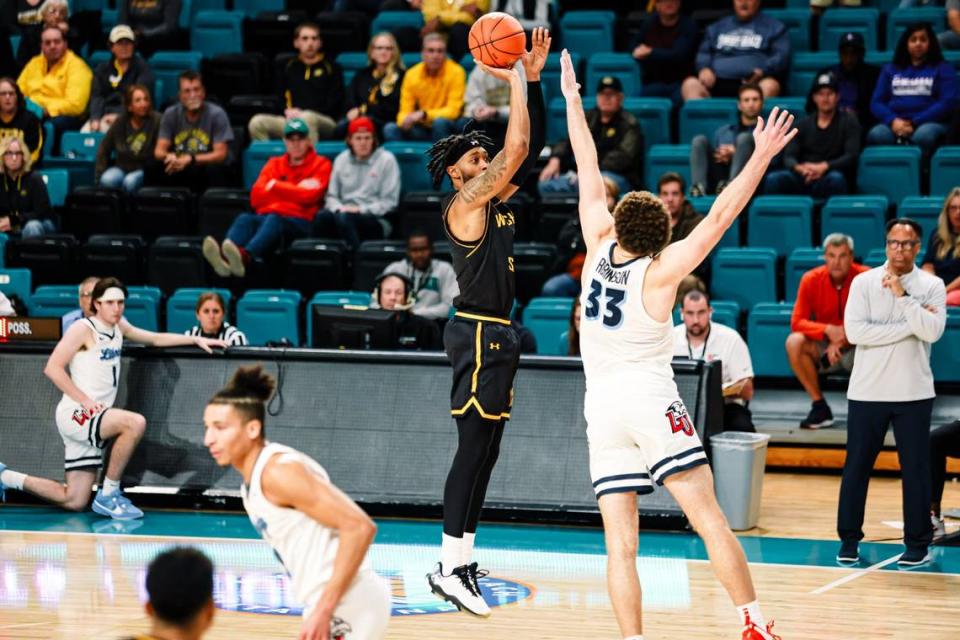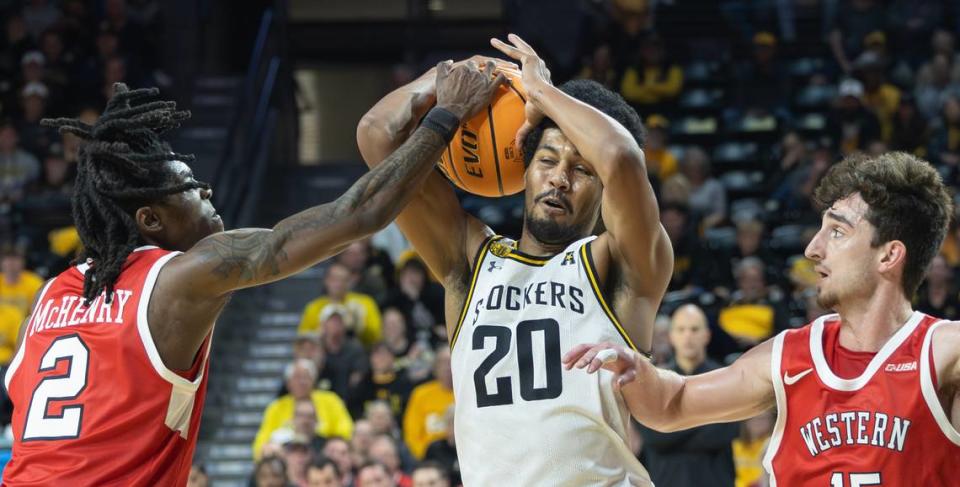The 4 lessons Wichita State basketball can learn from the Myrtle Beach Invitational
- Oops!Something went wrong.Please try again later.
From their corner in the gymnasium, members of the Wichita State men’s basketball team watched Liberty celebrate with the Myrtle Beach Invitational championship trophy.
When you play in an ESPN event, available television slots dictate the tournament schedule, and that left the Shockers waiting to play in the third-place game late Sunday evening after the hardware ceremony for Liberty, the team they had just lost to 48 hours ago.
“Sometimes in those third-place games, you’re so disappointed about not playing in the championship,” WSU head coach Paul Mills said. “There could have been an extra level of disappointment that you don’t get that opportunity to celebrate.”
Two hours later, any worries about a post-loss letdown had subsided and the Shockers were preparing to leave South Carolina with nothing but smiles following an 88-69 win over Saint Louis to improve to 5-1 this season.
The players were proud of how they handled the adversity following their first loss of the season.
“The main goal (Sunday) was to handle adversity the right way,” WSU center Kenny Pohto said after collecting a double-double of 23 points and 12 rebounds. “We wanted to let that last game go and move forward and just keep going. It was just one game. We have a whole season ahead of us. I thought we handled it pretty well.”
Here are some other lessons the Shockers feel like they are taking away from their November tournament and looking to apply for Saturday’s return to Koch Arena against Norfolk State.

Lesson No. 1: Kenny Pohto needs more touches on offense
On two of the first six possessions against Liberty, Pohto was given a touch along the perimeter, and he used his size advantage to methodically make his way toward the basket before finishing in the paint.
It looked like the 6-foot-10 junior, who plays power forward for WSU, was going to be a mismatch nightmare for Liberty.
Pohto didn’t score again for the final 38 minutes, taking only two more shots, logging one assist and failing to collect a rebound for the first time in 43 games.
“We’ve got to call more plays for him,” Mills said. “I thought a lot of the flow of the offense just led to (isolations) and (post-up’s). We took advantage of some switches, which is fine, but we have to find a way to get the ball in.”
Pohto was open several times after setting a screen and rolling to the basket or establishing position on the low block, but the entry passes were few and far between in a game where WSU’s guards became a little too eager to seek out isolation attacks.
“We probably have to have KP pop more and then play out of the cuts we get off that, as opposed to having him roll all the time to the rim,” Mills said. “Those were some really difficult passes to make with the people that we have right now.”
It was clear in WSU’s next game the message to feed Pohto had been delivered. The Swedish big man received a touch on the opening possession and found fellow big man Quincy Ballard for an alley-oop finish. WSU played through Pohto early and often, as he racked up eight points in the first six minutes and scored 14 points in the first half.
After his worst game of the season, Pohto bounced back with his best; he finished with 23 points, 12 rebounds and three assists in the Saint Louis win.
“The biggest thing we focused on was quicker decisions,” WSU guard Colby Rogers said. “If Kenny is open, give him the ball. Don’t wait and hold it. If you see the numbers on his chest, give it to him. We just needed to be quicker and more decisive and not hold onto the ball as long, trying to find the perfect solution. Just take what the defense gives you, trust our teammates and play with confidence.”

Lesson No. 2: The difference between seeing things on film and in a game
Liberty ranks 33rd in the country in minutes continuity this season, and that chemistry and experience in coach Ritchie McKay’s free-flowing system was on full display in a semifinal win over the Shockers.
It’s easy to watch film of a high-powered offense and be told by coaches the importance of communicating on defense and staying attached to shooters, but it’s hard to execute those details when an opponent moves the ball as quickly as Liberty.
WSU’s players learned that lesson the hard way in a 17-point loss where Liberty star forward Kyle Rode torched the Shockers for 31 points and seven 3-pointers.
WSU rotated a number of defenders on him, ranging from wing Harlond Beverly to forwards Isaac Abidde and Dalen Ridgnal, but they all struggled to stay attached to the shooter away from the ball. Rode found himself open on an array of pick-and-pops, exit screens for corner 3s and flare screens for wing 3s.
“It’s almost like an NBA team how they utilize their players,” Mills said. “You can’t trail some of their screens and we were trailing most of the time. We don’t see a whole lot of those exit screens and flare screens. We see a lot more bully-ball and people trying to get in the paint. But we’ve got to extend ourselves and you have to be really good on the ball, and I didn’t think we did either (that game).”
Liberty is one of the oldest teams in the country with players who have played together for years in the same system under an established coach in McKay. Meanwhile, WSU ranks No. 289 nationally in minutes continuity and was five games into the first season under a new coach in Mills.
That experience gap was never more obvious than during the four-minute stretch in the second half when Liberty put the game away with a 19-2 run. The ball zipped around the perimeter for Liberty, which made 24 passes in the eight possessions during the run. WSU was on the other end of the spectrum, as it made six total passes during that same span and had a possession that featured 28 dribbles and no passes, which predictably ended with a badly-missed shot.
“They spread the court so well and do a phenomenal job of knowing when to cut and how to cut and they utilize their non-shooters in an impressive way,” Mills said. “Players don’t necessarily understand what translates on film to what’s on the court. So we’ll get a ton out of this film and these will be some valuable lessons.”
It takes time — considerably more than WSU’s group has had together — to replicate the kind of chemistry Liberty has this season. The Shockers will close that gap over the course of this season, but a humbling 17-point loss makes for quite the effective film study on how far WSU has to go.
“We just play basketball the right way and we believe when you stick to that process, the results will come,” said Rode, a fifth-year senior. “We just have a great group of guys who hit the open man and I just happened to be open on some of those and make them.”

Lesson No. 3: Colby Rogers picking his spots better
In the Saturday film study, Mills challenged his star shooting guard to improve his decision-making after he needed 18 shots to score 16 points and turned the ball over four times against Liberty.
Rogers responded with a career-high 28 points on tidy efficiency (11-of-19 shooting) and just one turnover in 34 minutes.
“Colby is so fun to play with,” WSU guard Xavier Bell said. “I get to see how much he works day in and day out and it’s cool to see it translate to the games. He gets his defender rocking and when he gets to his spots, it’s over. It’s like clockwork watching him play.”
It’s true Rogers is having a prolific scoring season from the mid-range, where he has already made 19 jumpers on 51.4% accuracy through six games.
But before Sunday’s outburst, Rogers was shooting just 36.4% (8 of 22) on 3-pointers deemed to be high-quality looks (open and in rhythm) by an Eagle film study. For someone with 163 career 3-pointers to his name, 36.4% was below his standard.
WSU believes Sunday’s performance, which included 5-of-7 shooting beyond the arc, was positive regression. Rogers is now shooting 34.3% (12 of 35) on 3-pointers against Division I competition this season.
“I spend a lot of time in the gym working with the (graduate assistants) and our coaching staff,” Rogers said. “They always tell me to be aggressive and stay aggressive. As a shooter, sometimes it’s hard to find that rhythm, but the only way to find it is to stay in attack mode. You watch pros like Klay Thompson and Steph Curry and some games they’re not shooting it well, but they never lack confidence. That’s the one thing I always want to play with is that confidence and always be in attack mode.”
Picking his spots is still a work in progress for Rogers.
A good example came during the second half of the Saint Louis game, when freshman Joy Ighovodja drove the lane and kicked out to Rogers, who turned down a golden catch-and-shoot opportunity to instead settle for a pull-up 2-pointer that ended up missing badly.
If Rogers is a 50% 3-point shooter on open catch-and-shoot looks, WSU is expected to score 1.50 points per shot on that attempt, which means Rogers would need to generate a 2-point shot he can make 75% of the time to find equal value in a shot.
Even with Rogers leaving some meat on the bone and not capitalizing as often as he feels like he can from the outside, he has still managed to score efficiently (he has an offensive rating of 107.8). That’s encouraging for the rest of the season.
“Colby has such a beautiful shot, man,” Pohto said. “Every time he shoots it, it looks like it’s going in to me.”

Lesson No. 4: Better spacing can prevent future turnovers
The spacing of players on offense for WSU is critical because the team doesn’t have much shooting gravity to keep help defenders along the 3-point line.
WSU is at its best when the floor is properly spaced, which gives the ball handler plenty of room to operate when they attack the basket. That’s how the Shockers were punishing Liberty in the first half of the semifinal game until a halftime adjustment by the Flames negated that size advantage.
Every time a WSU ball handler tried to back down a smaller Liberty player in the second half, the Flames sent a second defender from the blindside to trap the ball handler. Liberty forced five turnovers in the second half alone by this method, as WSU’s ball-handlers were sometimes stripped without ever seeing the second defender coming.
Mills said turnovers like that in the future can be prevented by better spacing.
“I thought that had more to do with our spacing issues than ball-handling issues,” Mills said. “We would have the ball on the baseline and there would be a guy on the block and then we would drive it, instead of waiting for an open block. You’re just driving into traffic. And when you talk about our seam drives, we had one where we drove on the same side as an occupied corner and you’re just setting yourself up for trouble there. Whenever you drive seams, you can’t have occupied corners, and whenever you drive baseline, you can’t have occupied blocks. Since going through the film, I think our guys better understand that now.”
It’s another work-in-progress for the Shockers, who improved with their spacing in Sunday’s finale against Saint Louis but still had three turnovers that were the result of poor spacing.
The improvement is encouraging, but to borrow a popular Mills phrase, “good is the enemy of great” for the Shockers at this point in the season.
“It’s not an excuse, but we’re still working out some kinks and we’ve still got a lot to learn and a lot to get better at,” Rogers said. “We responded well (Sunday) and now it’s going to be about how we respond to this win. Are we going to get complacent or continue to get better? Mills always tells us discipline is about doing the next right thing, even when it’s tough. And that’s what we’ve got to do in our next game.”

